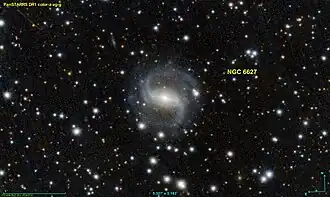NGC 6627
| NGC 6627 | |
|---|---|
 NGC 6627 imaged by Pan-STARRS | |
| Observation data (J2000 epoch) | |
| Constellation | Hercules |
| Right ascension | 18h 22m 38.9181s[1] |
| Declination | +15° 41′ 52.810″[1] |
| Redshift | 0.017565±0.000005[1] |
| Heliocentric radial velocity | 5,266±1 km/s[1] |
| Distance | 197.10 ± 15.05 Mly (60.432 ± 4.615 Mpc)[1] |
| Apparent magnitude (V) | 14.3[1] |
| Characteristics | |
| Type | (R')SB(s)b[1] |
| Size | ~93,000 ly (28.51 kpc) (estimated)[1] |
| Apparent size (V) | 1.3′ × 1.1′[1] |
| Other designations | |
| IRAS 18203+1540, UGC 11212, MCG +03-47-001, PGC 61792, CGCG 114-004[1] | |
NGC 6627 is a barred spiral galaxy in the constellation of Hercules. Its velocity with respect to the cosmic microwave background is 5,146±9 km/s, which corresponds to a Hubble distance of 247.6 ± 17.3 Mly (75.90 ± 5.31 Mpc).[1] However, 25 non-redshift measurements give a much closer mean distance of 197.10 ± 15.05 Mly (60.432 ± 4.615 Mpc).[2] It was discovered by German astronomer Albert Marth on 13 July 1863.[3]
NGC 6627 is an active galaxy nucleus candidate, i.e. it has a compact region at the center of a galaxy that emits a significant amount of energy across the electromagnetic spectrum, with characteristics indicating that this luminosity is not produced by the stars.[4]
Supernovae
Three supernovae have been observed in NGC 6627:
- SN 1998V (Type Ia, mag. 16) was discovered by British amateur astronomer Mark Armstrong on 10 March 1998.[5][6]
- SN 2018evy (Type II, mag. 17.503) was discovered by ATLAS on 11 August 2018.[7]
- SN 2021abkm (Type II, mag. 18.151) was discovered by ATLAS on 14 October 2021.[8]
See also
References
- ^ a b c d e f g h i j k "Results for object NGC 6627". NASA/IPAC Extragalactic Database. NASA and Caltech. Retrieved 3 August 2025.
- ^ "Distance Results for NGC 6627". NASA/IPAC EXTRAGALACTIC DATABASE. NASA. Retrieved 3 August 2025.
- ^ Seligman, Courtney. "New General Catalogue Objects: NGC 6627". Celestial Atlas. Retrieved 3 August 2025.
- ^ "NGC 6627". SIMBAD. Centre de données astronomiques de Strasbourg. Retrieved 3 August 2025.
- ^ Hurst, G. M.; Armstrong, M.; Boles, T.; Nakano, S.; Kushida, Y.; Kushida, R. (1998). "Supernova 1998V in NGC 6627". International Astronomical Union Circular (6841): 1. Bibcode:1998IAUC.6841....1H.
- ^ "SN 1998V". Transient Name Server. IAU. Retrieved 3 August 2025.
- ^ "SN 2018evy". Transient Name Server. IAU. Retrieved 3 August 2025.
- ^ "SN 2021abkm". Transient Name Server. IAU. Retrieved 3 August 2025.
External links
- NGC 6627 on WikiSky: DSS2, SDSS, GALEX, IRAS, Hydrogen α, X-Ray, Astrophoto, Sky Map, Articles and images